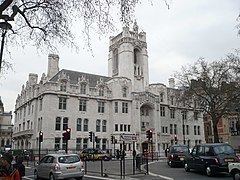Type Court building Completed 1913 Renovating firm Feilden+Mawson LLP Construction started 1906 | Renovated 2007–2009 Opened 1913 | |
 | ||
Architect James Glen Sivewright Gibson Similar Parliament Square, Two Chairmen, Methodist Central Hall - Wes, St Margaret's - Westminster, Queen Elizabeth II Conferen | ||
The Middlesex Guildhall is the home of the Supreme Court of the United Kingdom and of the Judicial Committee of the Privy Council. It stands on the south-west corner of Parliament Square in London.
Contents
- Map of Middlesex Guildhall Little George St Westminster London SW1P 3BD UK
- History
- Controversy over conversion
- References
Map of Middlesex Guildhall, Little George St, Westminster, London SW1P 3BD, UK
History
The location in Parliament Square was the site of the belfry of Westminster Abbey and it was used as a market from 1750 to 1800. The justices of the City and Liberty of Westminster took it over and an octagonal guildhall with a Doric portico was constructed by Samuel Pepys Cockerell in 1805. In 1889 Westminster became part of the County of London, outside the county of Middlesex. In the division of property between the Middlesex and London county councils, the guildhall at Westminster went to Middlesex in exchange for the Middlesex Sessions House in Clerkenwell. A neo-Tudor guildhall was constructed on the site in 1893 by F. H. Pownall.
The current building was built between 1912 and 1913, designed by J. S. Gibson, in what Pevsner called an "art nouveau gothic" style, and decorated with medieval-looking gargoyles and other architectural sculptures by Henry Charles Fehr. The county council and the Middlesex sessions were abolished in 1965 and the Guildhall continued to be used by the Greater London Quarter Sessions. After the abolition of the Quarter Sessions it was used as a Crown Court centre.
The Guildhall incorporates in the rear a doorway dating from the seventeenth century which was a part of the Tothill Fields Bridewell prison and moved to the site to be incorporated in the building.
The Middlesex Guildhall was closed for refurbishment in 2007 in order to convert it for use as the site of the new Supreme Court of the United Kingdom and the Judicial Committee of the Privy Council. The Supreme Court, established in law by the Constitutional Reform Act 2005, came into being on 1 October 2009.
Controversy over conversion
After the government chose the Middlesex Guildhall as home for the new Supreme Court, it was realised that a great deal of work was required to renovate the building and adapt it to the new use. Renovation plans were developed by architects Feilden+Mawson LLP, supported by Foster & Partners.
These plans attracted much controversy from conservation groups, which claimed that the conversion would be unsympathetic to such an important building. The Middlesex Guildhall is a Grade II* listed building, and the statement of importance by English Heritage classed the three main Court interiors as "unsurpassed by any other courtroom of the period in terms of the quality and completeness of their fittings" on 26 August 2004.
The conversion works involved the removal of many of the original fixtures and fittings. SAVE Britain's Heritage stated, "No other owner of a Grade II* listed building would be allowed to strip out interiors of this quality on the basis of a vague promise to display a few key pieces in the basement and find a home for the rest in some other building not yet designed or built."
